Positive Health Online
Your Country

Reflexology to Help Stress and Anxiety
listed in reflexology, originally published in issue 204 - March 2013
Reflexology can work very specifically to help the body heal itself and clients will often seek a reflexologist for help with common ailments such musculo-skeletal pain, insomnia, hormonal or digestive issues. In many cases they will see their symptoms improve or disappear but, by then, they have discovered how deeply relaxing reflexology can be to their whole being which results in better sleep, peace of mind and less anxiety. Reflexology appeals to many people because it is non-invasive; the only clothes to be removed are shoes and socks. The hands, as well as the feet, can be worked and this allows discrete self-help relaxing techniques to be applied at any time.
Reflexologists are trained to help balance the mind and body and to maintain this state of homeostasis the body needs to run smoothly. When there is a malfunction in the body it is thrown off balance. Reflexology helps to sustain a natural equilibrium in every gland, organ, muscle, tissue and cell in the body through stimulation of pressure points, called reflexes on the hands and feet.
Stress is a normal physical response to events when a person feels threatened, upset or their equilibrium is threatened in some way. At this point, the body's defences kick into a rapid, automatic process known as the fight-or-flight reaction, or the stress response. When there is a perceived threat, the nervous system responds by releasing a flood of stress hormones, including adrenaline and cortisol. These hormones rouse the body for emergency action and the blood pressure rises, the heart beats faster, senses become sharper and, for a brief period, stamina and strength can increase. These reactions are life preserving but many people live at this heightened state of anxiety all the time and that can take a physical, chemical and psychological toll on a person that impinges on every aspect of their life.
In the last decade many companies have put more emphasis on recognizing the massive impact on the economy and health services from stress-related illness. In 2005, at the 17th World Congress on Health and Safety at Work, the US National Safety Council reported:[1]
Work-related stress has only recently been recognized as one of the major causes of some of the most costly, time-robbing health problems for business; of 40.2 million working days lost by illness and injury, 13.4 million are from stress, anxiety, and depression.
Stress can be a chemical reaction; the physiological side of stress is governed by the autonomic nervous system (ANS) which plays an important role is stress management. The ANS is the unconscious part of the nervous system and comprises the sympathetic (fight and flight response) and the parasympathetic nervous system is responsible for digestion, reproduction and the repairing processes of the body. It is essential that these two parts of the nervous system are in balance. When too many of the body’s energies are being constantly diverted to control an anxious state of mind, the parasympathetic system is unable to function properly in its repair processes, reproduction and digestion.
Vertical Reflexology (also know as Vertical Reflex Therapy - VRT)[2] has many techniques available for stress-release including applying pressure on the pituitary reflexes on the centre of both thumb nails in turn (nail-on-nail) and holding for 30 seconds, the popular Diaphragm Rocking Techniques and the brief direct stimulation of the adrenal reflexes on the hand or foot appears to accelerate the body’s response.
In reflexology, the easily located adrenal reflex is situated just below the ball of each foot and is also on the palm side of the hand on the thenar muscle which is the fleshy area just below the thumb. Both points may feel slightly bruised to the touch, but a person may experience a lessening of tension, which may indicate a fall in adrenaline, after gently stroking and pressing these reflex points for a few minutes. This can be applied discretely to the hands at any time of the day or clients are recommended to work their feet for about 5 minutes per foot on waking and before bed. Rob Wood, a psychiatric nurse and reflexologist, conducted a study on the effects of reflexology on anxiety[3] and emphasized that, although each client is likely to experience an immediate sense of relaxation after each treatment, it is the cumulative effect on their anxiety symptoms that is the main purpose of the sessions. This is why they are offered 6 appointments and asked to state treatment goals that can be reviewed on completion. He reported:
Each client is shown VRT self-help techniques that they can use in situations where they feel stressed or anxious. Clients value this, as one of the reasons anxiety escalates is the feeling of not being in control. These techniques give a degree of control, (as well as actually having an effect!). The one that clients find most useful is ‘nail-on-nail’ on the pituitary. This can be applied ‘anytime/anywhere’, and is inconspicuous… (See protocol below)
Reflexology comes in many forms and Facial Reflexology created by Lone Sorenson[4] may be helpful as it claims to stimulate reflexes, via fingertip pressure trigger, the release of endorphins and serotonin, leaving the face feeling relaxed and rejuvenated. This technique combines the modern science of neurology with the ancient therapies of Traditional Chinese Medicine, South American Zone Therapy, and Vietnamese face maps and points. In this way facial reflexology stimulates blood circulation and lymphatic drainage in addition to balancing hormones and levelling emotions.
Dorthe Krogsgaard and Peter Lund Frandsen[5], of Touchpoint in Denmark, are leading reflexologists and use a combination of Classical and Nerve Reflexology (working the bony part of the feet to stimulate the central nervous system). In their article on Stress - therapy’s worst enemy?[4] they give particular advice for reflexologists when working on the origin of autonomic nervous system on the plantar (sole) of the feet. They suggest ways of working on reflexes for the Sympathetic and Para-sympathetic systems:
.jpg)
Fig 1 Working Sympathetic Reflexes.
The sympathetic reflexes are located along the first metatarsal and on the first cuneiform bone.
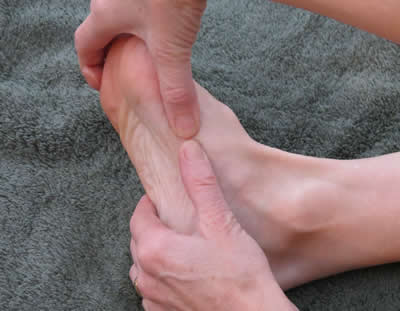
Fig 2 Working Parasympathetic reflexes.
The parasympathetic reflexes have two parts, one in the brainstem corresponding to the distal phalanx of the great toe reaching across the joint with the proximal phalanx. One efficient way of working these reflexes against the bone, is to place the thumb flat from medial against the bone, and then swing it around toward the plantar side, thus gently pushing away the soft tissue and getting the clear contact with the bony surface.
When working these areas classical reflexology techniques may be used to work through both sympathetic and parasympathetic systems and then let the body do the rebalancing of these systems.
If preferred, the techniques could be thought of in terms of stimulation and sedation. In stress situations, it would be beneficial to stimulate the parasympathetic side and relax the overloaded sympathetic branch.
Self-help Reflexology Tips for Stress
Diaphragm Rocking from the Vertical Reflexology repertoire is an extremely helpful reflexology technique which may be used to help sleep, as a relaxation aid, to regulate breathing and energize the body. Its key befit is that it appears to naturally prioritize and pump energy to the part of the body most in need.
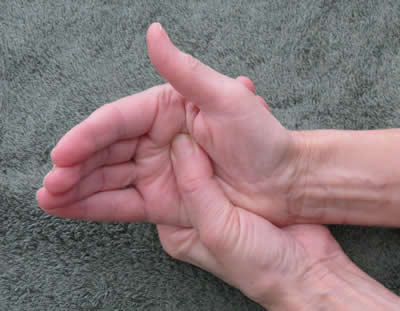
Fig 3 Diaphragm Rocking
Method
Lightly press your left thumb on the palm of your right hand, between your index and middle finger and 2-3 cm below (just below the raised fleshy area).Straighten your fingers and slowly curl them over your thumb, gently rocking your fingers back and forwards for 10-15 rocks and then repeat on the left hand.
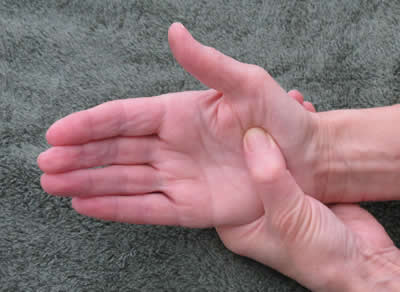
Fig 4 Adrenal Reflex
To boost energy and help relaxation: Start with Diaphragm Rocking as above and then add 30 seconds of stimulation to the adrenal reflex in the fleshy part of your palm below the thumb (on the thenar muscle). Just press your thumb lightly on the middle of the muscle and locate and then stimulate the most sensitive point, which is the adrenal reflex. It should not hurt but there may be a transitory sharp, tingling or bruised sensation.
Repeat on the other hand and return several times during the day as required.
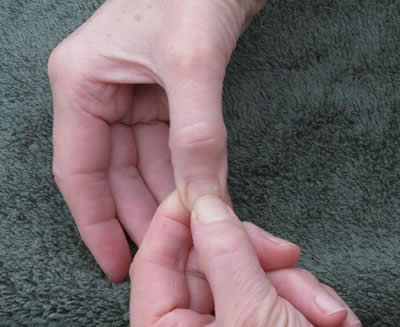
Fig 5 Pituitary Pinch, Nail-on-nail.
(b) The Endocrine (hormonal) system may benefit from a quick stimulation of the Pituitary reflex which is the master gland. Vertical Reflex Therapy (VRT) techniques include working nail-on-nail and the gland may be stimulated by one simple action: place and pinch your thumb nail in the centre of the other thumb nail and hold for 30 seconds. Repeat on the other hand.
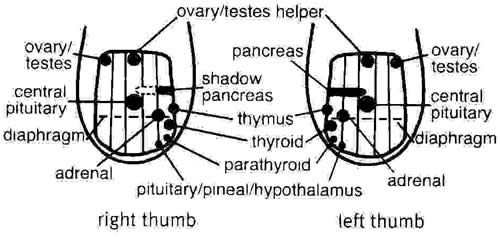
Fig 6 Example of Vertical Reflexology Endocrine Nail Reflexes
This VRT nail chart illustrates the more complex approach that reflexology can make to the endocrine system, but pressing the central point can give the whole system a boost.
References
1. The US National Safety Council: 2005 17th World Congress on Health and Safety at Work. www.nsc.org
2. Booth Lynne. Vertical Reflexology for Hands. Publ Piatkus Books, London. ISBN: 0-7499-2319-9 2003.
Booth Lynne. Vertical Reflexology. Publ Piatkus Books, London. ISBN: 0-7499-2132-3. 2000.
3. Wood Rob MIFR RMN Dip.Couns. Reflexology in the treatment of anxiety. robwood19@aol.com
4. Sorensen Lone. Instituto de Reflexología Podal Facial Internacional. www.lonesorensen.com
5. Krogsgaard Dorthe and Lund Frandsen Peter. Stress – therapy’s worst enemy? Touchpoint, Denmark www.touchpoint.dk
Comments:
-
Dr.Rajeswari said..
The article is very useful for self help through reflexology to reduce stress.thank you very much.
-
Jemal said..
all I say is thanks!!!